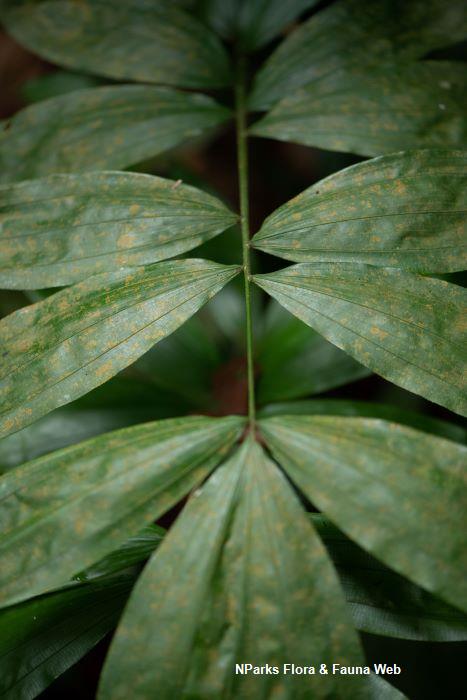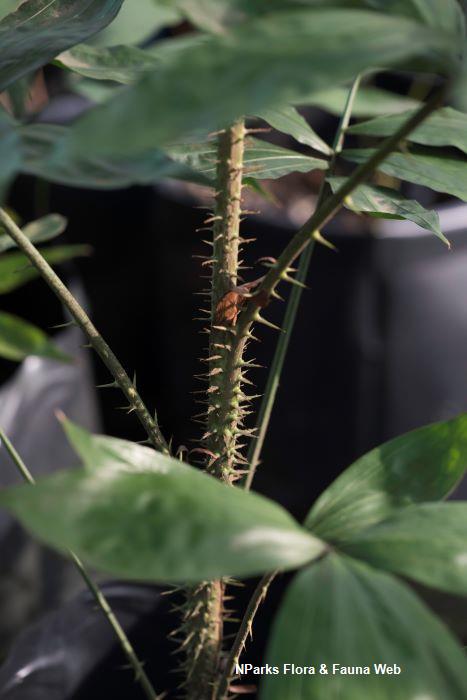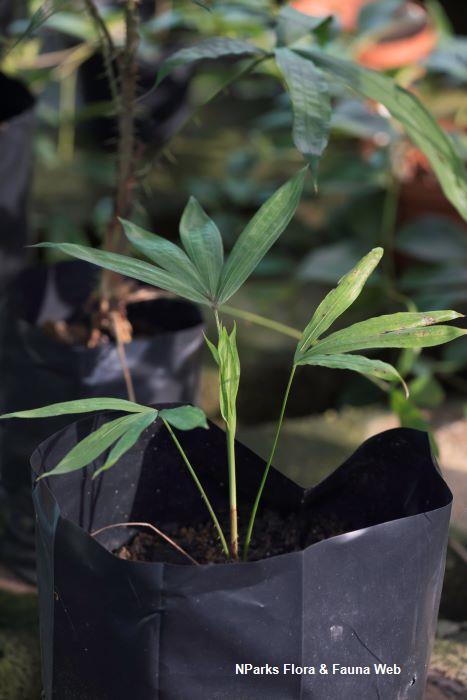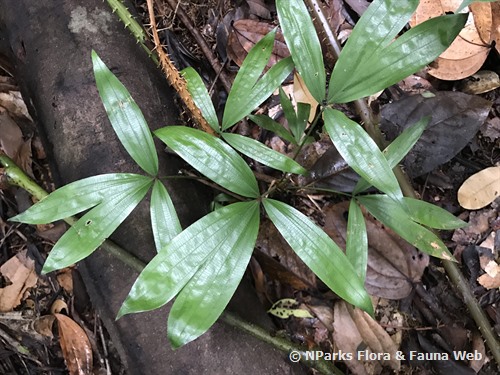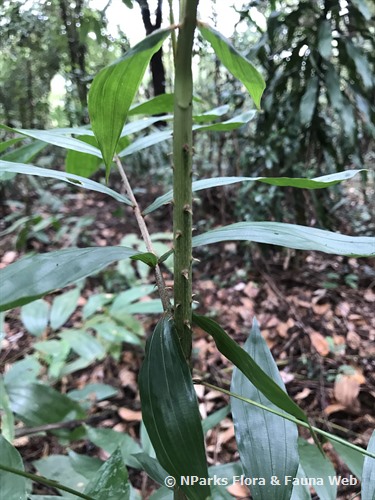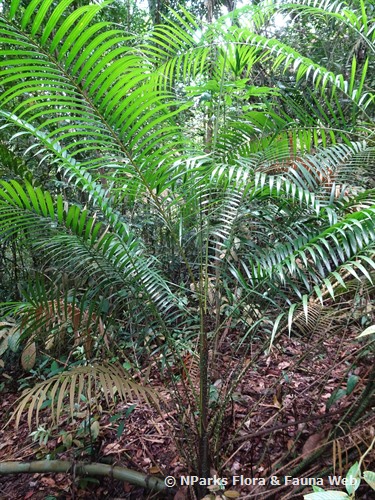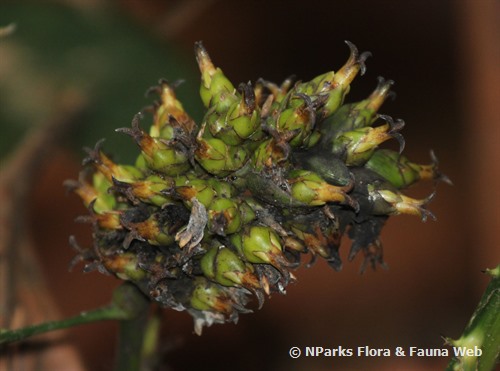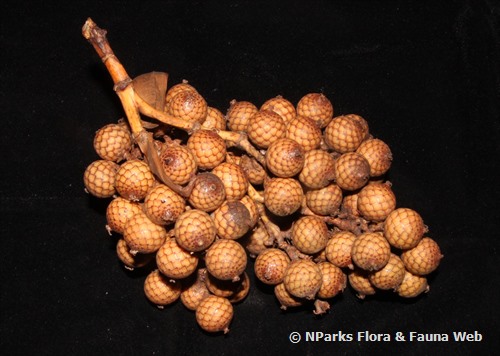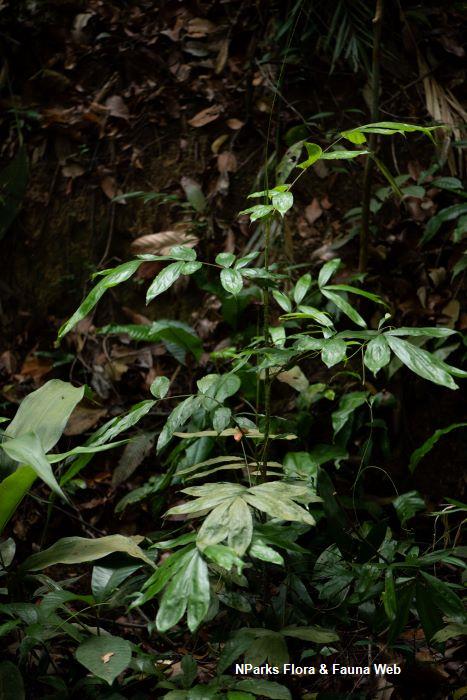
Back
Calamus javensis Blume
| Family Name: | Arecaceae (Palmae) |
| Synonyms: | Calamus equestris Blume nom. illeg., Calamus tetrastichus Blume, Palmijuncus javensis (Blume), Calamus borneensis Miq., Calamus acuminatus Becc., Calamus amplectens Becc., Calamus amplijugus J.Dransf., Calamus congestiflorus J.Dransf., Calamus corrugatus Becc., Calamus elopurensis J.Dransf., Calamus filiformis Becc., Calamus hypertrichosus Becc., Calamus impar Becc., Calamus kemamanensis Furtado, Calamus javensis var. peninsularis Becc., Calamus javensis var. intermedius (Becc.)Becc., Calamus javensis var. penangiana (Becc.) Ridl., Calamus javensis var. tenuissimus (Becc.) Becc., Calamus javensis var. purpurascens (Ridl.) Ridl, Calamus javensis var. inermis (Ridl.) Ridl., Calamus javensis var. sublaevis Becc., Calamus javensis var. acicularis Becc., Calamus javensis var. laevis Furtado, Calamus fissijugatus Burret |
| Common Name: | Rotan Lilin, Rotan Opot, Howe Cacing, Lempinit Ular-ular, Arorog, Arurug, Wai Tek, Wai Ukan |
Calamus javensis, or commonly known as Rotan Lilin, is a slender clustering rattan palm with a climbing habit, reaching a height of 10 m. This species is highly variable in morphology with several different forms found throughout Southern Myanmar, Peninsular Thailand, Peninsular Malaysia, Singapore, Sumatra, western Java, Borneo, & the Philippines.
Name
Classifications and Characteristics
| Plant Division | Angiosperms (Flowering Seed Plants) (Monocotyledon) |
|---|---|
| Plant Growth Form | Palm, Climber |
| Lifespan (in Singapore) | Perennial |
| Mode of Nutrition | Autotrophic |
Biogeography
| Native Distribution | Southern Myanmar, Peninsular Thailand, Peninsular Malaysia, Singapore, Sumatra, western Java, Borneo, & the Philippines (Palawan & central Luzon) |
|---|---|
| Native Habitat | Terrestrial (Primary Rainforest) |
| Preferred Climate Zone | Tropical, Highland / Montane |
| Local Conservation Status | Native to Singapore (Endangered (EN)) |
Description and Ethnobotany
| Growth Form | It is a slender clustering palm, forming low thickets or climbing up to 10 m in height. The species is a known polymorphic species with a highly variable morphology. |
|---|---|
| Foliage | The fronds are extremely variable. They can measure up to 35 - 40 cm in length, even-pinnately compound, and arranged alternately. The fronds lack a cirrus (an extended portion of the leaf rachis/midrib that aids in climbing in rattan). The leaflets are mostly lance-shaped to ovate, and 2 - 6 (-12) leaflets are arranged on each side of the rachis, grouped or rarely subregular. The lowermost 1 - 2 pairs are often swept back across the stem, and the adult fronds are always with terminal leaflets fused at 1/4 to 3/4 of the length. The longest leaflets measure approximately 20 cm long × 5 cm wide. The leaf sheaths are light green to dark brown when dry, and smooth or armed with various black-tipped spines in one or mixed orientations. The ochrea (extension of the leaf sheath beyond the petiole insertion in palms) is reddish, conspicuous, and rarely persistent. The petiole (leaf stalk) is absent or short (2 - 5 cm long) and sparsely armed with small, curved or clawed spines. Young fronds are tinged pink. |
| Stems | The stems are 5 - 20 mm in diameter (8 mm without leaf sheaths), and the internodes are up to 30 cm long but usually shorter. |
| Flowers | The inflorescence is long (up to 1.5 m long), pendulous, interfoliar (borne between the leaves/fronds) and ending with a flagellum (a spiny, whip-like, sterile modified inflorescence axis that aids in climbing in rattans). The spathe or penduncular bract has a tubular base that encloses the rachis, with sparse, small, and curved spines. The specious is dioecious, meaning male and female inflorescences are borne on separate plants. The male and female inflorescences are almost similar, with 4 - 8 branches: male inflorescences are finer/more slender, with 4 - 8 cm long rachillae (minor, secondary axes on inflorescences) and one male flower per axil, while the female inflorescence has 12 cm long rachillae with a pair of female and sterile male flowers per axil. |
| Fruit | The fruit is scaly, oblong to globose drupe (a fleshy fruit with thin skin and a single central seed), up to 12 - 15 mm long × 8 mm wide. The scales are yellow to brown with reddish margins. The seed is rounded, measuring 8 – 11 mm long ⨯ 7 – 10 mm wide. |
| Habitat | It can be found on a wide range of soils in the understorey of tropical lowland and highland rainforests, occurring from 0 to 2000 m above sea level. |
| Similar | Calamus javensis falls into a species complex with several other similar-looking Calamus species; many of which have been subsumed into Calamus javensis (species are listed in synonyms) except for Calamus tenompokensis, which can be differentiated by the angular petiole and rachis, a more robust leaf sheath, 8 - 9 pairs of regularly arranged large, elliptic leaflets, and swollen calyx lobes on male flowers. |
| Taxonomy | Most of the varieties and subvarieties of this species have been subsumed into Calamus javensis, except for var. polyphyllus. |
| Cultivation | It can be propagated by seed. |
| Etymology | The genus Calamus is derived from Greek kálamos, "reed" or "stalk", referring to the habit of the palm. The specific epithet javensis is Latin for 'from Java'. |
| Ethnobotanical Uses | Others: In Peninsular Malaysia, Sabah, and Sarawak, the stems (also known as canes) are made into cords and used by the indigenous people to create baskets, traps, and musical instruments. The Semai people formerly used the spiny leaf sheaths to make graters, the canes for the covers of blowpipe quivers, and the edible raw palm-of-heart for curing coughs. |
Landscaping Features
| Landscape Uses | Trellis / Arbour / Pergola |
|---|---|
| Thematic Landscaping | Naturalistic Garden |
| Usage Hazard - Cons | Spines/Thorns - Flower, Spines/Thorns - Leaf, Spines/Thorns - Stem/Branch |
| Usage Hazard - Cons Remarks | Spine/Thorns (Leaf/Flower/Stem/Branch): The plant is covered in sharp spines and bristles and may not be suitable for landscaping in areas with high human traffic. |
Plant Care and Propagation
| Light Preference | Semi-Shade |
|---|---|
| Water Preference | Moderate Water |
| Plant Growth Rate | Moderate |
| Rootzone Tolerance | Moist Soils |
| Propagation Method | Seed |
Foliar
| Foliage Retention | Evergreen |
|---|---|
| Mature Foliage Colour(s) | Green |
| Mature Foliage Texture(s) | Spiny / Bristly / Stinging, Papery |
| Foliar Modification | Flower/Fruit Bract, Prickle / Emergence (blade) |
| Foliar Type | Compound (Even-Pinnate) |
| Foliar Arrangement Along Stem | Alternate |
| Foliar Attachment to Stem | Petiolate |
| Foliar Shape(s) | Palm Fronds (Pinnate / Feather) |
| Foliar Venation | Parallel |
| Foliar Apex - Tip | Acuminate |
| Leaf Area Index (LAI) for Green Plot Ratio | 4.0 (Palm - Cluster) |
Non - Foliar and Storage
| Trunk Type (Palm) | Clustering Habit |
|---|---|
| Stem Type & Modification | Thorn / Prickle |
| Root Type | Underground (Fibrous Root) |
Floral (Angiosperm)
| Flower & Plant Sexuality | Unisexual Flowers , Dioecious |
| Flower Colour(s) | Green, White |
|---|
| Flower Grouping | Cluster / Inflorescence |
| Flower Location | Axillary |
| Ovary Position | Superior / Hypogynous |
| Flowering Habit | Polycarpic |
| Flowering Calendar | Apr, Aug |
Fruit, Seed and Spore
| Mature Fruit Colour(s) | Yellow / Golden, Brown, Red |
|---|---|
| Mature Fruit Texture(s) | Scaly |
| Fruit Type | Fleshy Fruit , Drupe |
| Seed Quantity Per Fruit | Few (1-5) |
References
| References | Atria, M., Dransfield, J. & van Welzen, & P.C. (2023). Revision of the rattan Calamus javensis Blume complex (Arecaceae, Calamoideae) in Malesia with notes on all recognisable taxa and forms. Nordic Journal of Botany: 1- 16
Mogea, J.P., (1993). Calamus javensis Blume. In: Dransfield, J. and Manokaran, N. (Editors): Plant Resources of South-East Asia No 6: Rattans. PROSEA Foundation, Bogor, Indonesia. |
|---|
Image Repository
Others
| Master ID | 30959 |
|---|---|
| Species ID | 5345 |
| Flora Disclaimer | The information in this website has been compiled from reliable sources, such as reference works on medicinal plants. It is not a substitute for medical advice or treatment and NParks does not purport to provide any medical advice. Readers should always consult his/her physician before using or consuming a plant for medicinal purposes. |

